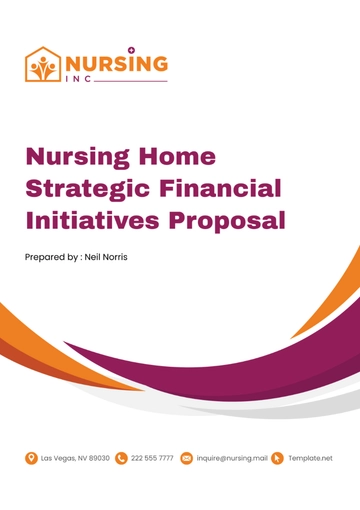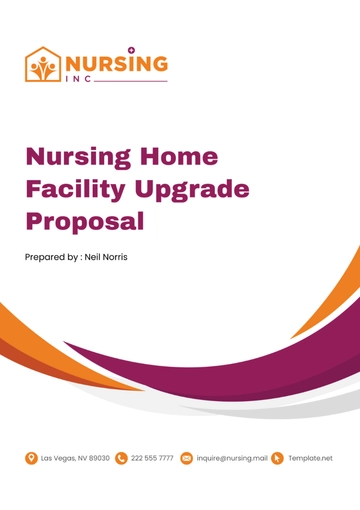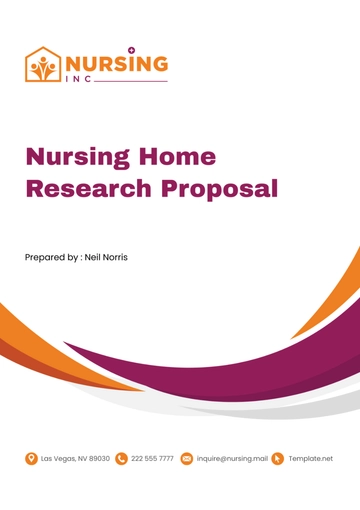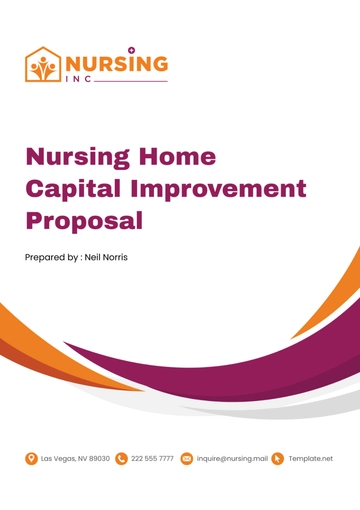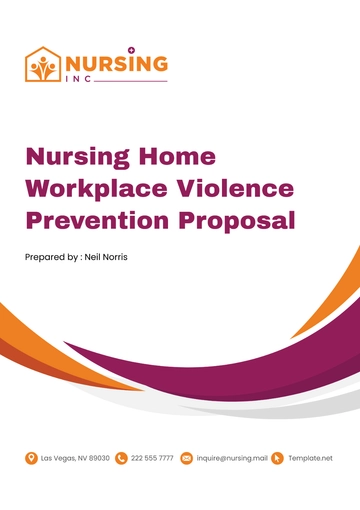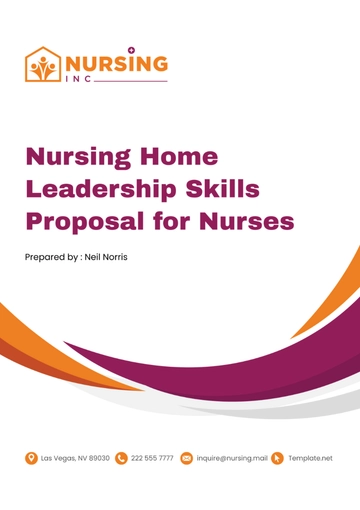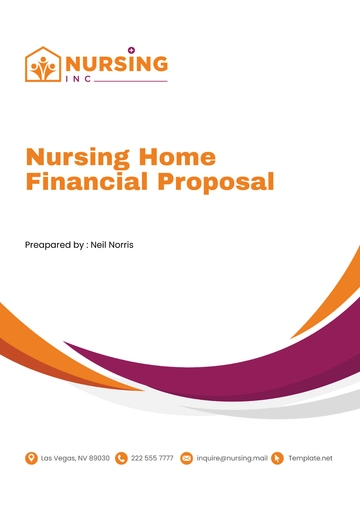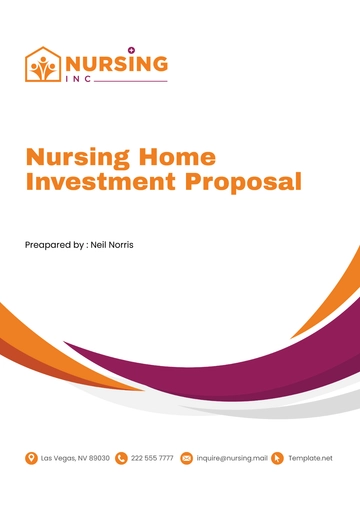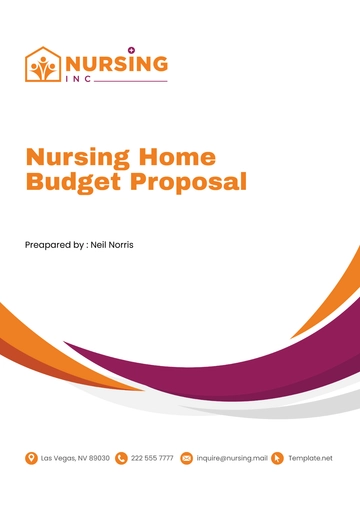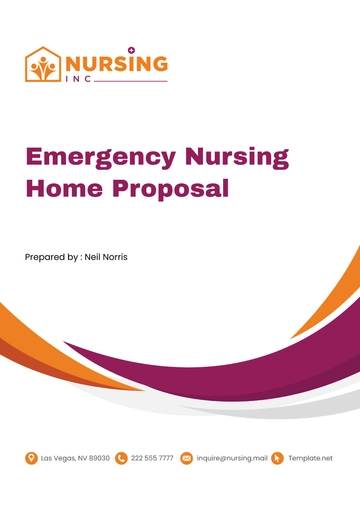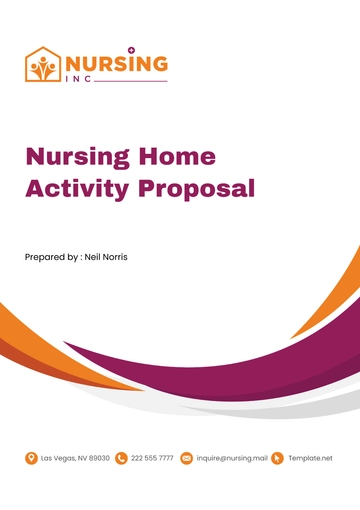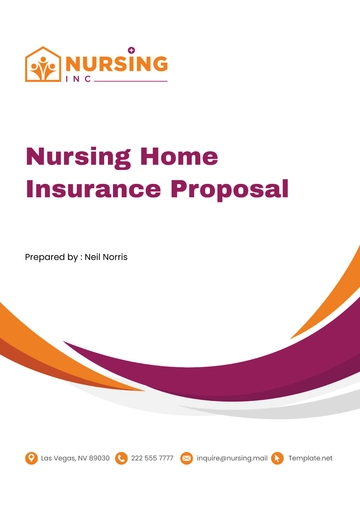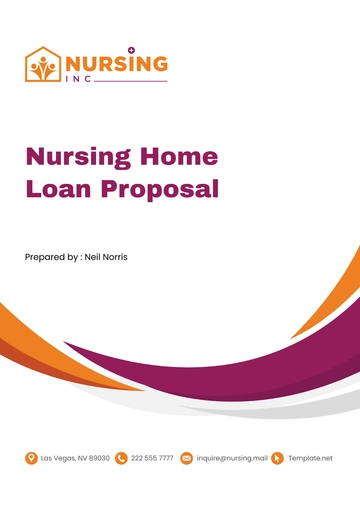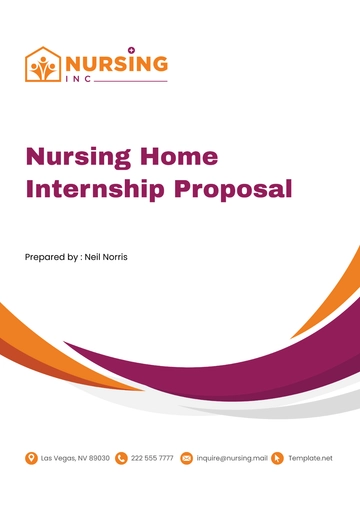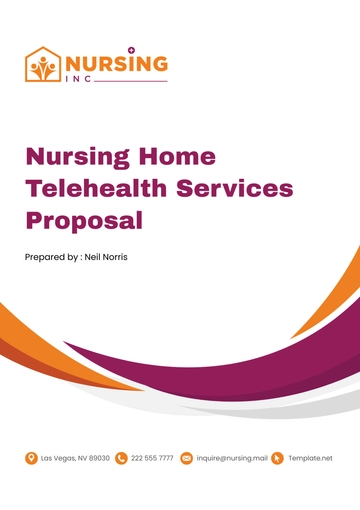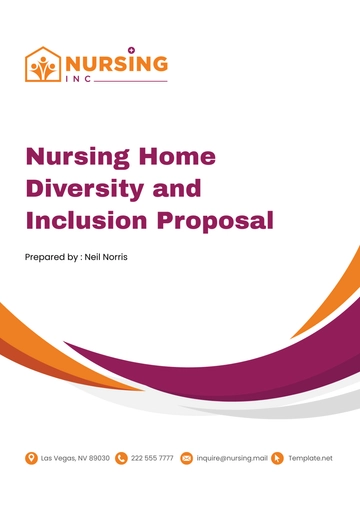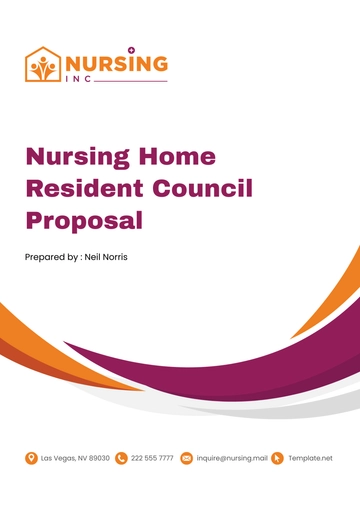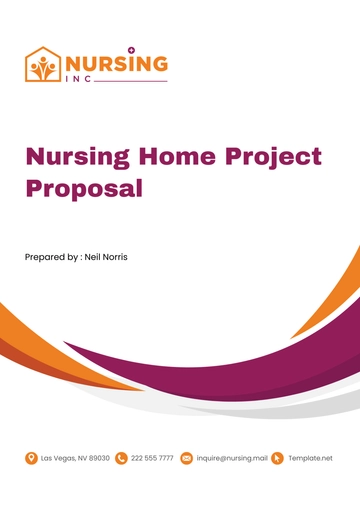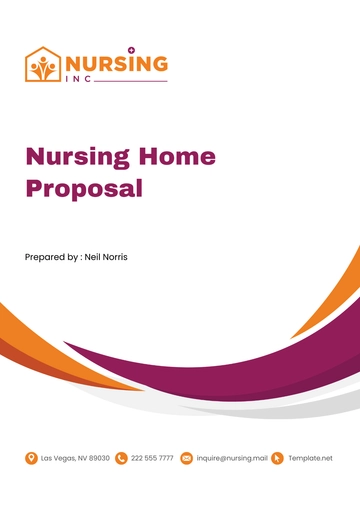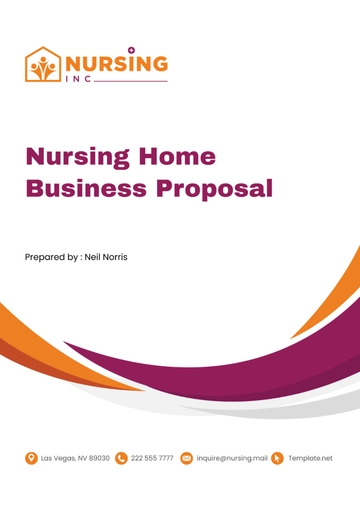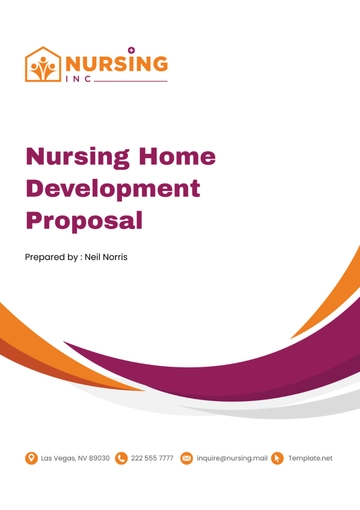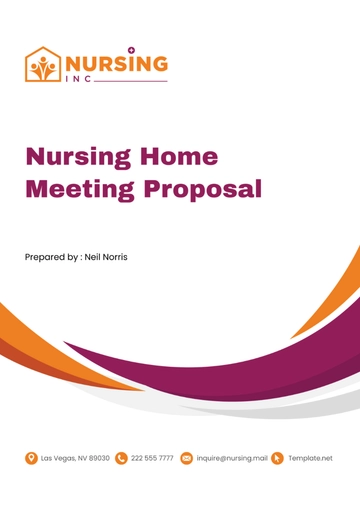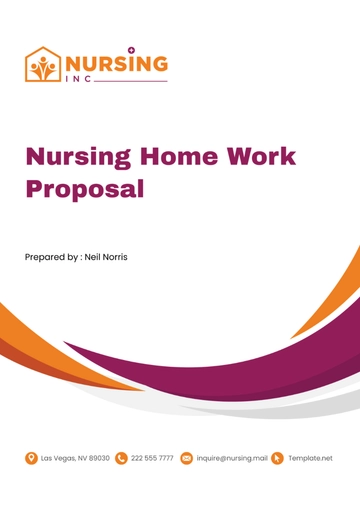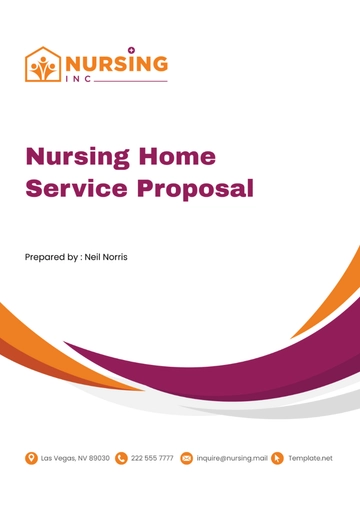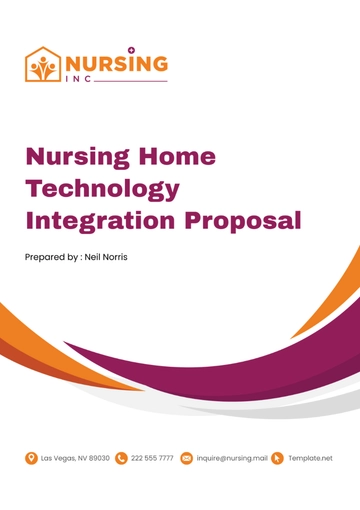Free Nursing Home Financial Proposal
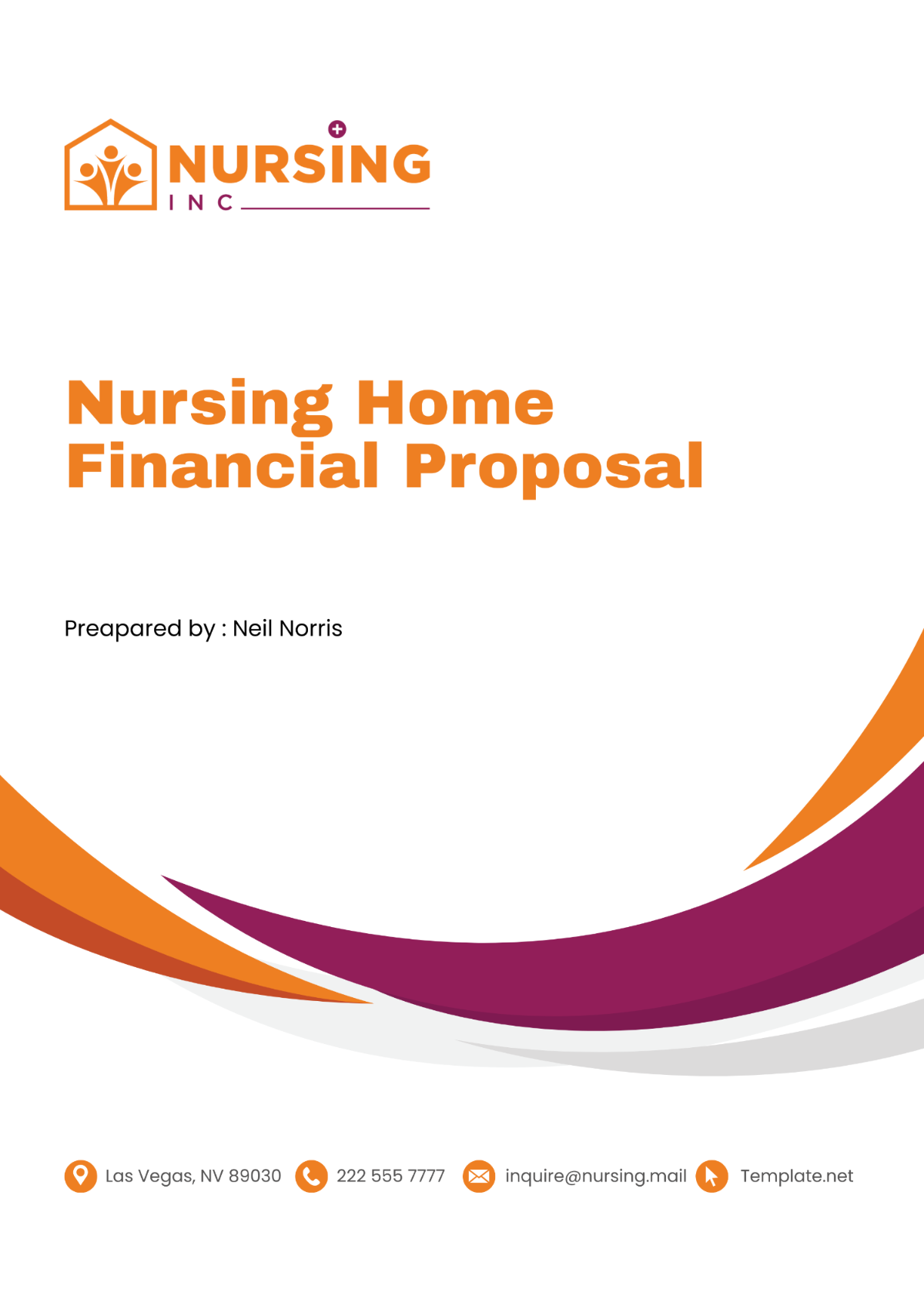
I. Executive Summary
[Your Company Name] is pleased to present this Nursing Home Financial Proposal, outlining the financial aspects of establishing and operating our premier nursing home facility. Our proposal encompasses detailed financial projections, investment requirements, and revenue streams to ensure the financial viability and success of this venture.
The proposed nursing home facility aims to provide exceptional care and support for elderly individuals in [Location], addressing the growing demand for high-quality long-term care services in the area. Through our comprehensive approach to healthcare and commitment to excellence, we anticipate significant opportunities for financial sustainability and growth.
II. Introduction
The need for quality nursing home facilities continues to rise as the population ages and the demand for long-term care services increases. In [Location], there is a clear gap in the availability of specialized nursing home facilities catering to the unique needs of elderly individuals. [Your Company Name] aims to fill this void by establishing a state-of-the-art nursing home facility that prioritizes compassion, dignity, and personalized care.
III. Project Scope and Objectives
The primary objective of [Your Company Name] is to provide exceptional long-term care services to elderly residents in [Location]. Our facility will offer a range of comprehensive services, including skilled nursing care, rehabilitation therapy, memory care, and assisted living options. Key objectives of the project include:
Providing a safe, comfortable, and nurturing environment for residents.
Ensuring compliance with all regulatory standards and licensing requirements.
Recruiting and retaining a team of highly qualified healthcare professionals.
Establishing partnerships with local healthcare providers and community organizations.
Achieving financial sustainability and profitability while maintaining high-quality care standards.
IV. Financial Analysis
A. Start-up Costs
This table outlines the anticipated expenses required to establish [Your Company Name].
Item | Amount (in $ million) |
|---|---|
Construction and Renovation | $2.5 million |
Equipment and Furnishings | $1.2 million |
Licensing and Permit Fees | $0.3 million |
Initial Staffing Expenses | $1.0 million |
Marketing and Promotion | $0.5 million |
Contingency Fund | $0.5 million |
Total Start-up Costs | $6.0 million |
B. Operating Expenses
This table details the estimated monthly operating expenses for [Your Company Name].
Expense | Monthly Amount (in $ million) |
|---|---|
Payroll | $0.8 million |
Utilities | $0.3 million |
Maintenance and Repairs | $0.2 million |
Insurance | $0.4 million |
Administrative Expenses | $0.2 million |
Medical Supplies | $0.3 million |
Total Monthly Expenses | $2.2 million |
C. Revenue Projections
This table presents the projected annual revenue streams for [Your Company Name].
Revenue Source | Annual Amount (in $ million) |
|---|---|
Private-Pay Residents | $4.0 million |
Medicare Reimbursements | $2.5 million |
Medicaid Reimbursements | $1.8 million |
Insurance Payments | $1.0 million |
Other Funding Sources | $0.5 million |
Total Annual Revenue | $9.8 million |
D. Financial Projections
This table provides key financial metrics and projections for [Your Company Name].
Metric | Amount |
|---|---|
Net Income | $3.5 million |
Cash Flow | $3.2 million |
Return on Investment (ROI) | 15% |
V. Funding Plan
To finance the establishment and operation of [Your Company Name], we propose the following funding plan:
Equity Investment: [Your Company Name] is seeking equity investment from private investors or venture capital firms to provide initial capital for start-up costs, including construction, equipment, licensing fees, and initial staffing expenses. Equity investors will have the opportunity to become shareholders in the nursing home facility and participate in its long-term success. We aim to raise approximately $5 million through equity investment.
Bank Loan: In addition to equity investment, [Your Company Name] will secure a commercial loan from a reputable financial institution to supplement our funding needs. The bank loan will cover a portion of the start-up costs and provide working capital for initial operations. We anticipate obtaining a loan of approximately $7 million with favorable terms and competitive interest rates.
Government Grants: Exploring opportunities for government grants or subsidies available for healthcare infrastructure development will be a key component of our funding strategy. We will actively research and apply for grants offered by federal, state, and local government agencies, as well as non-profit organizations dedicated to supporting healthcare initiatives. These grants will help offset construction costs, equipment purchases, and other eligible expenses. We aim to secure grants totaling approximately $2 million.
Partnerships: Collaborating with healthcare organizations, insurance providers, and other stakeholders will be instrumental in securing additional funding and support for [Your Company Name]. We will explore partnerships with hospitals, rehabilitation centers, home healthcare agencies, and medical practices to streamline referrals, access resources, and enhance service delivery. Strategic partnerships may also involve joint ventures, revenue-sharing agreements, or co-marketing efforts to maximize revenue and minimize costs.
Community Engagement and Fundraising: Engaging with the local community and leveraging fundraising efforts will supplement our funding plan and generate support for [Your Company Name]. We will organize fundraising events, awareness campaigns, and outreach initiatives to raise awareness about our facility and generate goodwill within the community. These efforts will not only generate additional funds but also foster positive relationships with potential residents, families, and donors.
Contingency Planning: [Your Company Name] will develop a contingency plan to address unforeseen financial challenges or funding gaps that may arise during the establishment and operation of the nursing home facility. This plan will include strategies for cost reduction, revenue enhancement, renegotiation of contracts, and accessing emergency funding sources if needed. By proactively identifying and mitigating risks, we will ensure the financial stability and sustainability of [Your Company Name].
VI. Risk Analysis
While [Your Company Name] presents significant opportunities for success, it is essential to recognize and mitigate potential risks and challenges that may impact its financial performance and operational stability. Our comprehensive risk analysis includes identifying key risks and developing strategies to manage and minimize their potential impact.
Regulatory Compliance:
Risk: Changes in healthcare regulations, licensing requirements, or reimbursement policies may affect the operational and financial landscape of the nursing home facility. Non-compliance with regulatory standards could lead to fines, penalties, or loss of accreditation, impacting the facility's reputation and revenue streams.
Mitigation Strategy: [Your Company Name] will establish robust compliance protocols, regularly monitor regulatory changes, and invest in staff training to ensure adherence to all applicable laws and regulations. We will maintain open communication with regulatory agencies, engage legal counsel as needed, and conduct internal audits to assess and address compliance gaps proactively.
Market Competition:
Risk: Intense competition from existing nursing home facilities, home healthcare providers, and alternative care options may impact [Your Company Name]'s ability to attract and retain residents. Price competition, quality of care, and location proximity are key factors influencing market competitiveness.
Mitigation Strategy: [Your Company Name] will differentiate itself through superior quality of care, personalized services, and innovative programs tailored to meet the diverse needs of residents. We will conduct market research to identify competitive strengths and weaknesses, develop targeted marketing strategies, and foster strong relationships with referral sources to enhance our market position.
Staffing Shortages:
Risk: Difficulty in recruiting and retaining qualified healthcare professionals, including registered nurses, licensed practical nurses, and certified nursing assistants, may impact the delivery of care and operational efficiency. Staffing shortages could lead to increased labor costs, overtime expenses, and potential burnout among existing employees.
Mitigation Strategy: [Your Company Name] will implement competitive compensation packages, professional development opportunities, and employee recognition programs to attract and retain top talent. We will prioritize staff training, invest in technology and automation to optimize workflow, and explore alternative staffing models, such as temporary staffing agencies or telehealth services, to mitigate the impact of staffing shortages.
Economic Factors:
Risk: Economic downturns, fluctuations in healthcare reimbursement rates, and changes in consumer spending patterns may impact [Your Company Name]'s financial performance and revenue streams. Reduced disposable income, rising healthcare costs, and changes in insurance coverage could affect occupancy rates and payer mix.
Mitigation Strategy: [Your Company Name] will maintain financial resilience by diversifying revenue streams, implementing cost containment measures, and establishing contingency funds to weather economic uncertainties. We will actively monitor economic indicators, collaborate with payers to negotiate favorable reimbursement terms, and adjust pricing strategies and service offerings to adapt to changing market conditions.
Public Health Emergencies:
Risk: Public health emergencies, such as pandemics, natural disasters, or infectious disease outbreaks, pose significant risks to [Your Company Name]'s operations and financial stability. These events may lead to facility closures, increased healthcare costs, supply chain disruptions, and reputational damage.
Mitigation Strategy: [Your Company Name] will develop and regularly update comprehensive emergency preparedness plans, including infection control protocols, communication strategies, and contingency staffing arrangements. We will collaborate with local health authorities, hospitals, and community organizations to coordinate response efforts, procure essential supplies, and ensure resident safety and well-being during emergencies.
Litigation and Liability:
Risk: Legal disputes, claims of negligence, or allegations of malpractice may expose [Your Company Name] to litigation, liability, and financial losses. Adverse legal outcomes, settlements, or insurance claims could strain financial resources and damage the facility's reputation.
Mitigation Strategy: [Your Company Name] will prioritize resident safety, quality of care, and risk management practices to minimize the likelihood of legal disputes and liability claims. We will invest in liability insurance coverage, engage legal counsel to assess and mitigate legal risks, and implement robust documentation and incident reporting procedures to support defense strategies in the event of litigation.
VII. Appendices
The appendices include additional supporting documents, such as:
Market Research Reports
Facility Floor Plans
Regulatory Compliance Information
Financial Statements
Resumes of Key Personnel
VIII. Conclusion
In conclusion, [Your Company Name] is excited to pursue the establishment of a premier nursing home facility in [Location]. With a solid financial plan, dedication to excellence in care, and strategic partnerships, we are confident in the success and sustainability of this venture. We welcome the opportunity to discuss our proposal further and invite potential investors or partners to join us in this important endeavor.
- 100% Customizable, free editor
- Access 1 Million+ Templates, photo’s & graphics
- Download or share as a template
- Click and replace photos, graphics, text, backgrounds
- Resize, crop, AI write & more
- Access advanced editor
Create compelling financial proposals for nursing home facilities with Template.net's Nursing Home Financial Proposal Template. Editable in our AI Editor Tool, this customizable template provides a structured format for presenting financial plans, including budget projections, revenue strategies, expense management, and investment opportunities. Enhance communication, attract stakeholders, and ensure financial sustainability effortlessly!
You may also like
- Business Proposal
- Research Proposal
- Proposal Request
- Project Proposal
- Grant Proposal
- Photography Proposal
- Job Proposal
- Budget Proposal
- Marketing Proposal
- Branding Proposal
- Advertising Proposal
- Sales Proposal
- Startup Proposal
- Event Proposal
- Creative Proposal
- Restaurant Proposal
- Blank Proposal
- One Page Proposal
- Proposal Report
- IT Proposal
- Non Profit Proposal
- Training Proposal
- Construction Proposal
- School Proposal
- Cleaning Proposal
- Contract Proposal
- HR Proposal
- Travel Agency Proposal
- Small Business Proposal
- Investment Proposal
- Bid Proposal
- Retail Business Proposal
- Sponsorship Proposal
- Academic Proposal
- Partnership Proposal
- Work Proposal
- Agency Proposal
- University Proposal
- Accounting Proposal
- Real Estate Proposal
- Hotel Proposal
- Product Proposal
- Advertising Agency Proposal
- Development Proposal
- Loan Proposal
- Website Proposal
- Nursing Home Proposal
- Financial Proposal
- Salon Proposal
- Freelancer Proposal
- Funding Proposal
- Work from Home Proposal
- Company Proposal
- Consulting Proposal
- Educational Proposal
- Construction Bid Proposal
- Interior Design Proposal
- New Product Proposal
- Sports Proposal
- Corporate Proposal
- Food Proposal
- Property Proposal
- Maintenance Proposal
- Purchase Proposal
- Rental Proposal
- Recruitment Proposal
- Social Media Proposal
- Travel Proposal
- Trip Proposal
- Software Proposal
- Conference Proposal
- Graphic Design Proposal
- Law Firm Proposal
- Medical Proposal
- Music Proposal
- Pricing Proposal
- SEO Proposal
- Strategy Proposal
- Technical Proposal
- Coaching Proposal
- Ecommerce Proposal
- Fundraising Proposal
- Landscaping Proposal
- Charity Proposal
- Contractor Proposal
- Exhibition Proposal
- Art Proposal
- Mobile Proposal
- Equipment Proposal
- Student Proposal
- Engineering Proposal
- Business Proposal
